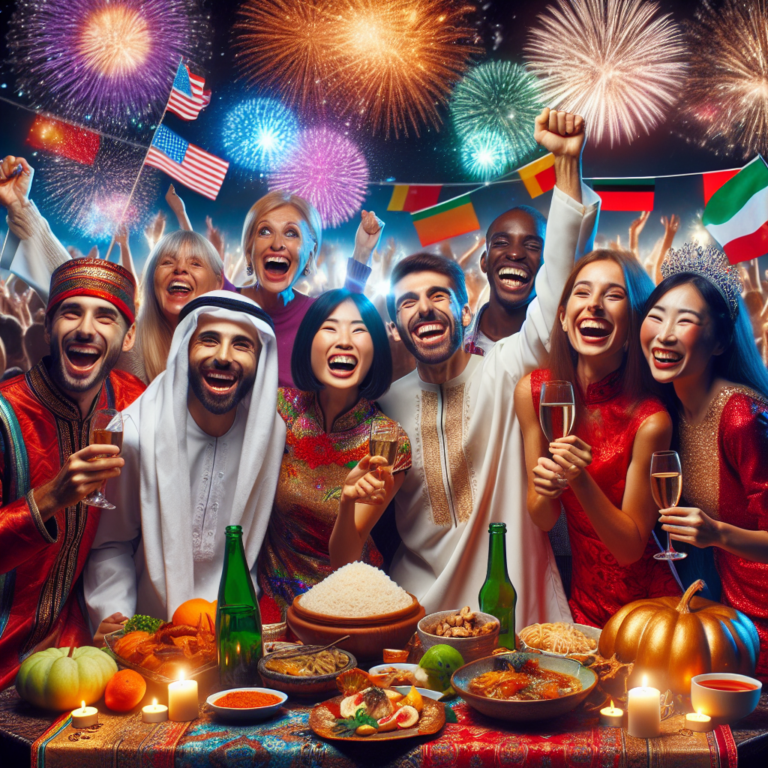Curiosities of New Year’s Eve: Traditions and Superstitions Around the World
New Year’s Eve is undoubtedly one of the most anticipated celebrations of the year. Marked by parties, traditions, and rituals that vary from culture to culture, this special moment is an opportunity to reflect on the past year and, moreover, welcome the new year with hope and enthusiasm. Let’s explore some fascinating curiosities about how different parts of the world celebrate this date.
Origin of New Year’s Eve Celebrations
First, it’s interesting to note that New Year’s celebrations have ancient roots. The Babylonians were the first to celebrate the New Year about 4,000 years ago. However, their festivities occurred in March, during the spring equinox. With the adoption of the Gregorian calendar in 1582, December 31 was established as New Year’s Eve, thus unifying the celebrations in many countries.
New Year’s Eve Traditions Around the World
- Spain: In Spain, a popular tradition is to eat 12 grapes at midnight, one for each chime of the clock. Each grape symbolizes luck for each month of the coming year. This practice is accompanied by much excitement and anticipation.
- Brazil: In Brazil, wearing white on New Year’s Eve is a tradition that symbolizes peace and renewal. Additionally, many people go to the beach to jump seven waves, a ritual believed to attract luck and good energies for the new year. If you’re planning to visit some of Brazil’s most beautiful beaches, check out our article on 5 Paradise Beaches in Brazil You Need to Visit.
- Japan: In Japan, New Year’s Eve, known as “Omisoka,” is a time of reflection and purification. Families gather for a special dinner and ring the bells of Buddhist temples 108 times, representing the purification of the 108 worldly desires.
Superstitions and Symbolisms of New Year’s Eve
- Fireworks: The use of fireworks on New Year’s Eve has its origins in ancient China. They were used to ward off evil spirits and consequently bring good luck. Today, they are an essential part of celebrations in many countries.
- Midnight Kiss: In many Western countries, the tradition of kissing someone at midnight is common. It is believed that this ensures affection and strong bonds in the coming year, being a gesture of love and friendship.
- Lentils and Pomegranates: Eating lentils or pomegranates on New Year’s Eve is a symbol of prosperity and abundance in various cultures. These foods are associated with luck and plenty. To explore more about food traditions, see our article on Typical Foods of Rio Grande do Sul.
Famous New Year’s Eve Events
- Times Square, New York: The ball drop in Times Square is one of the most famous New Year’s events in the world. Millions of people watch the event live or on television, marking the countdown to the new year.
- Sydney, Australia: Sydney is one of the first major cities to celebrate the New Year due to its time zone. The fireworks display on the Sydney Harbour Bridge is world-famous and attracts spectators from all over the world.
New Year’s Resolutions
Making New Year’s resolutions is a common practice where people promise personal changes, such as losing weight, saving money, or learning something new. Although many make resolutions, studies show that only about 8% of people actually achieve their goals throughout the year. However, the act of setting resolutions is a way to start the year with positive intentions. If one of your resolutions is to improve your finances, check out our guide on Loto Fácil: 2 Simple Steps to Win.
Conclusion
New Year’s Eve is a time of celebration and hope, filled with traditions and superstitions that vary from culture to culture. Regardless of how you choose to celebrate, it is an opportunity to reflect on the past and look to the future with optimism. May the coming year bring new opportunities and achievements for everyone!
For more information on New Year’s traditions around the world, visit National Geographic to explore fascinating articles and stories.


